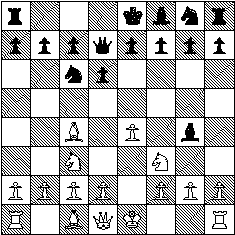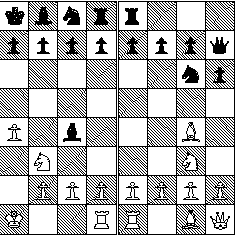
![]()


![]()

The board before and after a swap of the halves.
Note that the swap happens after five moves, not five pairs of moves. In other words, play proceeds WBWBW [swap] BWBWB [swap] WBW...
A player who is in check and will be taken out of check by a swap after his or her move is not required to do anything else to defend against check. Castling is unaffected: the Queen's rook is exactly as far away from the King in both configurations of the board. (Though the utility of castling is arguable, as the rooks are in the middle of the board half the time, now.) The en passant rule is probably also unaffected, but we never remembered to play with it anyway, so beware.
The only other rule change regards completion of a move: for a fair game, the player who moved before a swap must be allowed to take a move back and make a different one. Now matter how good you are at visualization, you will always at some point realize that you have made a crucial error only after the halves of the board have been swapped. Naturally, if swapping reveals that the last move was illegal (for example, by exposing the King to check), it is required that it be taken back.
We found that passing counters back and forth (the three-move player giving the two-move player a coin with each move, for example) was helpful in keeping track of how many moves since the last swap. It is surprising how easy it is to lose track.
Finally, make sure that the pieces aren't going to fall over every
time you pick the two halves of the board up to move them. Being
schizoid is difficult enough without being unstable as well.